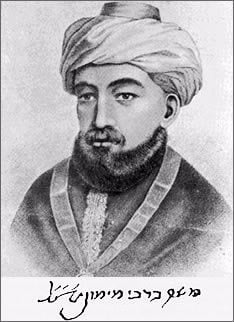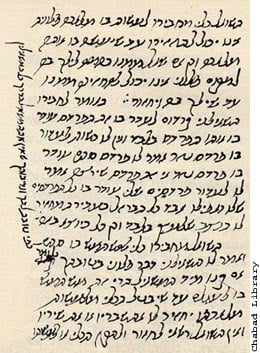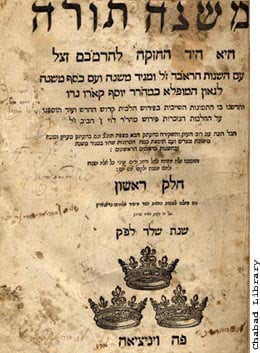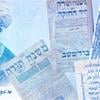Rabbi Moshe ben Maimon was a Talmudist, Halachist, physician, philosopher and communal leader, known in the Jewish world by the acronym "Rambam" and to the world at large as "Maimonides." He is one of the most important figures in the history of Torah scholarship; on his gravestone were inscribed the words, "From Moses to Moses, none arose as Moses."
Today, many hospitals and schools across the globe are named after Maimonides; and to this day, students worldwide pore over his scholarly works.
Biography
Main Article: The Rambam: A Biography

Moshe was born in Cordoba, Spain, on the 14th of Nissan (the eve of Passover) of the year 4895 (1135 C.E.1). His father Maimon, a direct descendant of King David, was a judge in the city's rabbinical court. His mother passed away when he was yet a small child, some suggesting that his younger siblings were born after Maimon remarried.2
At the age of thirteen, his family was forced to flee Cordoba when a fanatic Islamic sect took control of the city; the Jews were attacked by rioters and many synagogues were destroyed.
Moshe and his family traveled from place to place looking where to relocate. Not finding anything suitable in Spain, he and his father and younger brother, David, moved to Fez, Morocco, for five years. In 4925 (1165 C.E.), he visited the land of Israel and then moved to Alexandria, Egypt. Later, he settled in Fustat, today known as Old Cairo, where he lived until his passing.
In Egypt, Maimonides was supported by his brother David, a merchant who imported diamonds from India. His financial support gave Maimonides the ability to devote himself to the study of Torah and to author his scholarly work on the Mishnah, the 2nd century seminal work on Jewish law.
Tragedy befell him when his father, wife and two of his sons died within a span of two years, starting in 1166. Several years later, in 1171, his brother David drowned when his ship sunk en route to India.
Without the support of his brother, he began practicing medicine and struggled to support himself and his brother's family.
In his mid-fifties, Maimonides was appointed as a personal physician by a royal courtier and then to Saladin, the sultan of Egypt and Syria. His new appointments and duties gave him financial stability and more – albeit still very limited – time to devote to his writing.
His son and faithful student, Abraham, was his only remaining immediate family member.
Maimonides passed away on the 20th of Tevet of the year 4965 (1204 C.E.) and was buried in the city of Tiberias in the Holy Land.
Scholarship
Main Article: Talmudist

At a young age, Maimon personally educated his son and brought him to the revered teacher, Rabbi Yosef ibn Migash, known as the Ree Migash, a rabbi in Alusina, Spain (today known as Lucene). Maimonides would later consider him his primary mentor.
In his mid-20s, he began authoring numerous volumes on the Mishnah, which he completed around ten years later. His intent was to assist those who could not understand the Mishnah's Hebrew and often cryptic text, and for that reason, the commentary was written in Arabic but with Hebrew lettering.
He then wrote a volume in Arabic called Sefer Hamitzvot, listing all of the 613 commandments. These volumes were later translated into Hebrew numerous times, once still in his lifetime.
Additional Works
Main Article: Responsa
Maimonides also authored the Guide for the Perplexed, or Moreh Nevuchim, a foundational work on Jewish philosophy; the Letter of Martyrdom, a letter to Yemenite Jews encouraging them in their difficult plight; and other letters (gathered together in Pe'er Hador and today published as a single volume). Maimonides also wrote an Oath for Physicians, and various medical texts are attributed to him.
Code of Jewish Law
Main Article: Codification of Jewish Law

Maimonides' magnum opus is his codification of Jewish law, which he called Mishneh Torah, or "second to the Torah." The fourteen volume work is a logical systematic codification of Jewish law.
Prior to Maimonides, in order to know Jewish law, one would have to learn the entire Talmud. And since the Talmud itself as at times indecisive, often incorporating conflicting opinions on Jewish law, it was necessary to then study the various commentaries, which clarified the final law. The famed Rabbi Yitzchak Alfasi, known as the Rif (the teacher of the aforementioned Ree Migash) was the first to codify applicable Jewish law—as a commentary to the Talmud.
The difficulty was, however, that the Talmudic rulings – as well as the aforementioned commentaries – were not organized in a strictly encyclopedic, logical fashion, making research extremely taxing. For example, in order to study the laws of Shabbat by exploring the Talmud, one needs to search through tens of tractates.
Maimonides was the first one to index the entire body of Oral Law – both Talmuds, the various halachic Midrashim, later works authored by the Geonim, and even kabbalistic texts – and compile it all in a logical and systematic fashion. The laws of Shabbat, for example, are all gathered in the third volume of Mishneh Torah (which is titled Zmanim, "Times," containing all laws pertaining to Shabbat and holidays) in thirty chapters, each divided into bite-sized sub-sections.
Maimonides codified the laws of Shabbat, holidays, prayer, dietary laws, and the laws that regulate the Jew's daily life. He also wrote a section on eating healthy, fitness, and mental health—teaching future learners that all our actions should be permeated with holiness and G‑dliness. "The health and wellbeing of the body," he writes, "is part of one's service of G‑d."
The Mishneh Torah also incorporates the basics of Jewish thought and belief.
Another unique component of the volumes is that they are not limited to laws that pertain to our day and age, which constitute only a small part of the 613 biblical commandments, but also include laws that will pertain to the Messianic era, such as the laws of tithing, the Jubilee Year, and the Temple service.
In this area, Maimonides was more than a trailblazer; to this very day the Mishneh Torah remains the only work of this scope. No other work – authored beforehand or afterwards – covers the entire corpus of Jewish law. (Even the commentaries on Jewish law authored before Maimonides omit the laws that were not germane at the time.)
Maimonides also placed great emphasis on making his works available and understandable to all Jews, scholars and laymen alike. He also omitted sources, for brevity's sake, though later scholars compiled sources for every statement in the Mishneh Torah. Because of his unique style and clarity, he became known as "The Golden Tongue."
Since Maimonides, many subsequent scholars have analyzed every word and even letter in his volumes. They discuss at length why Maimonides chose to include certain laws, wrote one law before another, and why he chose to include laws in one volume but not the other. Some have speculated that the body of commentary on Maimonides' volumes could reach the same quantity as Talmudic commentary.
Daily Study of Maimonides' Works
Main Article: Daily Study of Maimonides' Works

In the spring of 1984, the Rebbe, Rabbi Menachem Mendel Schneerson, of righteous memory, called for an innovative addition to the daily study schedule of every Jewish man, woman and child. He suggested that everyone study daily a portion of Maimonides' Mishneh Torah.
The Rebbe suggested a three-track system: three chapters daily, one chapter daily, or to study every day from the Sefer Hamitzvot. This suggestion was enthusiastically accepted by tens of thousands, bringing Maimonides' works to unparalleled prominence.
Today, Jews across the globe celebrate at the completion of the cycle every year.






Join the Discussion